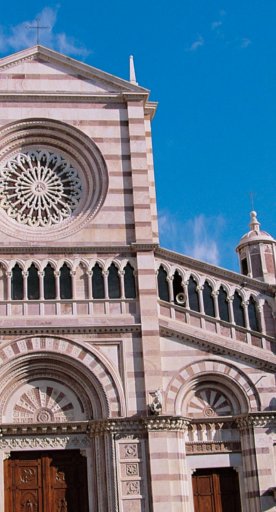Castiglione della Pescaia: a beach town in Maremma
An old coastal fishing village with beautiful unspoiled landscapes
If you're looking for a vacation filled with fun, relax and nature, Tuscan treasure Castiglione della Pescaia is a sure guarantee to finding all that and more. This scenic seaside destination is located in the Grosseto area of southern Tuscany, vaunting splendid views of Elba and Giglio islands (not too far from the Argentario promontory). Whatever you're looking for, this town has it all: wild landscapes, unspoiled scenery and excellent food and wine.
The name Pescaia indicates its history as an old fishing village (in Italian, pescare means fishing). The town dates to Roman times (Salebrone) and was later inhabited by Umbrians and Etruscans, as it was considered an ideal location due to the lake gracing the area (now the Diaccia Botrona marsh), which provided essential food and goods.
-
1.What to see in Castiglione della Pescaia
-
2.Around Castiglione della Pescaia
-
3.How to reach Castiglione della Pescaia

During the Middle Ages, a series of pirate attacks caused periods of strife for the city, though it eventually found safety under the Pisans. The Republic of Pisa used Castiglione della Pescaia as a sea base and built three towers still visible today, which make up the core components of the defensive fortress.
More difficulty ensued following the natural transformation of Lake Prile into a lagoon: the inhabitants once used salt from the lake, however, the progressive lack of salinity caused its transformation into a marsh, bringing malaria with it. The 13th century was thus plagued by difficulty for Castiglione's residents. It was only under the Lorraine dynasty that a series of projects were carried out to enhance their living conditions. Thanks to a deep reclamation process and the growing importance of the port (especially before the Maremma railway line) the town witnessed a period of rebirth in late 18th century, leading to its nickname, "Little Livorno.”
What to see in Castiglione della Pescaia

Castiglione della Pescaia is divided into upper and lower towns: the upper town is built on a hill facing the sea, while the lower town rests directly beneath, mainly composed of coastal areas and sandy beaches.
Beaches: the long sandy beaches of Castiglione della Pescaia are a great destination for families traveling with children - thanks to their crystal-clear water and diverse facilities operated by bathing establishments. To get a sense of this location's popularity, consider that during high season tourist influx increases the population tenfold. You'll find a large range of beach options in the area, from fully equipped bathing establishments to wild nature and secluded beaches. Castiglione della Pescaia is also a paradise for summer sports enthusiasts, from sailing to windsurfing.

City Walls: Castiglione contains remains of two different city walls. The Pisans erected a first fortified perimeter in the 10th century, delimiting the village on the hill from the lower settlement. Over time, constant pirate attacks led inhabitants to move to higher ground, abandoning the area near the river. In the 15th century, the Aragonese (and later the Sienese) built new walls to delimit the village we see today (situated around the castle). The castle walls still preserve three entrance gates: San Giovanni, Madonna del Giglio and del Castello.
Castiglione Castle: this fortress is the village’s dominating structure. The original building dates to the 10th century when the Pisans first built a tower. In the 15th century, the Aragonese further enlarged the structure and turned it into a fortress, which was further modified by by Cosimo I de’ Medici and later, the Lorraine family. In the early 20th century the castle was entirely transformed to became a private residence, closing it off to visitors until today (it is still under private ownership).
Pineta di Tombolo: this coastal pine forest in located in the province of Grosseto and extends from Castiglione della Pescaia to the Padule della Trappola. The vast area stretches about 15 kilometers along the coastline, all within a protected nature area.
Around Castiglione della Pescaia
Diaccia Botrona Natural Reserve: this is all that remains of the age-old Lake Prile, an Etruscan treasure that later became the Roman Portus Traianus. This area is considered one of Italy’s most important wetlands, vaunting a rare ecosystem recognized internationally. Here, you can take a walk, ride a bike or motorcycle along paved roads and trails that meander through scrub, pine needles and moss.
Casa Rossa Ximenes: this beauty is located in the Diaccia Botrona Nature Reserve. Dating to 1765, the structure was commissioned by the Lorraine to engineer and mathematician Leonardo Ximenes. The complex was built to control the flow of water from the vast marshy area of Castiglione Lake to the Tyrrhenian Sea. Despite no longer serving its original function, the house is well preserved and was recently restored and converted into a reception center for the Diaccia Botrona Nature Reserve. The casa also houses the Casa Rossa Ximenes Multimedia Museum (since 2009).

Vetulonia: this is one of the most important Etruscan settlements in Italy, where you can visit the necropolis and archaeological museum dedicated to Isidoro Falchi, the leading archaeologist who discovered Vetulonia in the 19th century. The artifacts discovered prove this Etruscan center’s importance, which survived by mining the area’s natural resources. Here, you can also visit the Castle of Colonna, an imposing medieval fortress dating to the 7th century.
Buriano: the ancient town of Buriano boasts a medieval castle and wonderful views of the Maremma. The Rocca Aldobrandesca fortress dominates the village, built by the Aldobrandeschi family in the 10th century. Transformed throughout time, the building is still visible today with its well-preserved ruins.
How to reach Castiglione della Pescaia

By train: The closest train stations are in Grosseto and Follonica. From there, you'll have to take a bus to reach Castiglione della Pescaia.
By bus: Check out this link to route your journey by bus: http://www.tiemmespa.it/
Don't miss reading more about the best beaches near Castiglione della Pescaia in Maremma.








































































